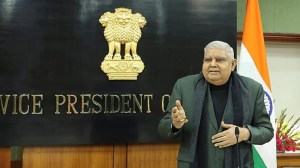Netflix series delves into the life of a police informer: Meet the Gurdaspur man behind CAT, a series on Punjab’s dark decade
From its creator to cast, language to locations— CAT has Punjab deeply embedded into it at every level.
 (Left) Actor Randeep Singh Hooda in a still from Balwinder Singh Janjua’s (right) eight-episode series , CAT, on Netflix.
(Left) Actor Randeep Singh Hooda in a still from Balwinder Singh Janjua’s (right) eight-episode series , CAT, on Netflix. Currently trending as the No 1 TV show on OTT platform Netflix, CAT is an eight-episode series set in the 1990s insurgency-hit Punjab, on the many shades of the life of Gurnaam Singh, a young man who becomes CAT (police informer) and infiltrates a powerful politician’s drug trade in Punjab. The Punjab Police had unofficially engaged many mukhbirs or ‘Cat’ as they were popularly called, to infiltrate the network of militants to flush out terrorism from the state.
The success of CAT on Netflix, a global OTT platform, probably the first exhaustive work on a plot set in Punjab, a border state which continues to face issues such as drugs and security, also comes as a long overdue appreciation for Punjabi language and hundreds of local artists/actors/crew members that the series makers engaged to ensure a largely authentic picture. From its creator to cast, language to locations— CAT has Punjab deeply embedded into it at every level.
The creator, co-director, producer and writer of the series is Balwinder Singh Janjua (41), who had shifted to Mumbai nearly 20 years ago from Kathiali village of border district Gurdaspur in Punjab, to fulfil his dream of being a showman. Speaking to The Indian Express, Janjua said that as a creator he ‘wanted to narrate a real story of his own land Punjab.’
“Though CAT is a work of pure fiction, it is inspired from what we saw, heard during that period. My father was in the Indian Air Force (IAF) but we used to visit our village often. It is the story of the people we know, what they went through during the black period in Punjab. It is a human story. Thanks to the outreach that OTT platforms have these days, CAT is being widely watched. It wasn’t possible to tell such an exhaustive story in a three-hour film,” says Janjua. “People of Punjab went through a lot during the insurgency and it continues to have its repercussions even today. Somewhere as a writer, creator I always had that urge to tell a real story of my own land,” says Janjua.
“To keep it balanced, we have tried to portray the double life that Gurnaam led,” he adds. CAT comes as a long overdue win for Punjabi too, with the majority of actors hailing from Punjab, speaking their mother tongue on screen in authentic dialect.
“I strongly feel that the story of a particular region should be told in its own language. It should not look fake. Had a Punjabi man been shown speaking Hindi on screen, it would have taken out the entire essence from the story. For the series, we engaged at least 80-90 actors and crew from Punjab—local artists, theatre guys to fresh faces,” says Janjua. The series was shot over 90 days across Majha region of Punjab— border districts Amritsar, Gurdaspur and Tarn Taran—the worst affected during terrorism. “The idea was also to generate employment and give work to local artists,” he adds. The lead role of CAT Gurnaam Singh, is played by Randeep Singh Hooda, whom Janjua describes as a “method actor.” “Though the film was never released, he (Hooda) actually grew a beard for years for his role of a Sikh soldier in ‘Battle of Saragarhi’. He is a method actor who seeps into his character. The day he signed CAT, he started speaking in Punjabi with everyone to practise the language,” says Janjua, on selecting Hooda, a Haryana native, for lead role.













